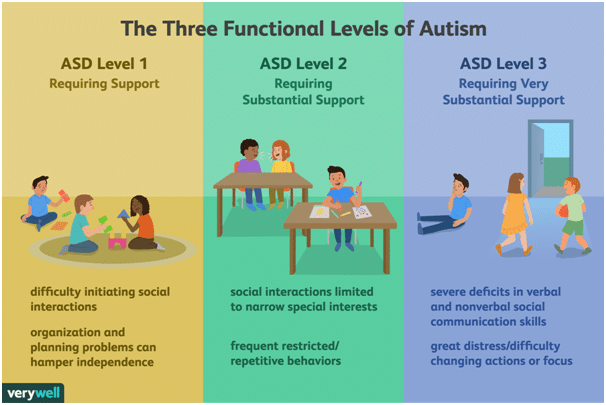Autism
What is Autism
- Autism spectrum disorder (ASD) is a complex developmental condition that affects social communication, interactions, and behaviour. In India, it remains widely misunderstood and underdiagnosed.
- Signs of ASD can vary but difficulty with social interactions, communication challenges, repetitive behaviours, and restricted interests are common.
- Early diagnosis and intervention are crucial for better outcomes and support for families.
- According to the Diagnostic and Statistical Manual of Mental Disorders (DSM-5), ASD is considered to be a single disorder.
- The DSM itself is a handbook that doctors and researchers use to diagnose and study mental health conditions; DSM-5 is the latest edition.
The levels of ASD
- The DSM-5 assesses the severity of ASD by evaluating social communication and restricted, repetitive behaviours.
- The severity of ASD is determined by assigning a level of support such as 1, 2 or 3 based on the individual’s need for assistance and the impact of their symptoms on their daily lives.
- The level that the doctor assigns will reflect how much external assistance a person is likely to need for their day-to-day activities.
- Assessing this correctly can help doctors and other specialists work with the individual to provide the right kind of support.
- Level 1 is where a person with autism may have social challenges that need some help.
- They may have trouble starting conversations, responding to others, or making friends without the right forms of help. They may also have a need for routine and organisation.
- At level 2, the person needs more support than at Level 1.
- Communication challenges can make it hard for the individual to have coherent conversations or understand nonverbal cues. Daily routines and changes may also cause significant distress.
- It is at level 3 that the person needs the highest level of support. They may avoid interacting with others, have difficulty making friends or participating in imaginative play, and find it very hard to change their focus or routines.
- Repetitive behaviours may affect their ability to function, and communication challenges will be significant.
Identifying autism
- Getting an autism diagnosis for a child is a two-step process.
- First, the child receives developmental check-ups during routine healthcare visits at around 18 and 24 months old.
- During these check-ups, a doctor talks to the parent or caregiver about the child’s behaviour, development, and family history, and looks for signs of autism.
- If the doctor suspects autism, the child will move on to the second stage of evaluation, involving a team of healthcare professionals that will conduct further assessments to determine if the child has autism and what kind of support they may need.
- It is important to seek an evaluation if you have concerns about your child’s development or behaviour, as an early diagnosis can help the child reach their full potential.
- The road to a diagnosis will include various professionals, including child psychiatrists, psychologists, speech-language pathologists, and occupational therapists.
- These experts will evaluate a child’s cognitive and language skills, sensory issues, and other concerns. Additional tests may be required to rule out other conditions.
- For older individuals, symptoms of autism may be noticed by caregivers, parents, teachers, or other people who interact with them, leading to a medical evaluation.
- Diagnosis can be particularly challenging in these instances, as the symptoms can be similar to other mental health conditions, such as obsessive-compulsive disorder.
Tools for screening
- Doctors have many methods to screen for autism, including informal observations and formal assessments. The methods can range from simple observations to more structured tests.
- One common screening tool is the Modified Checklist for Autism in Toddlers (M-CHAT) Revised.
- This is a 20-question test for children aged 16-30 months. However, recent evidence suggests that M-CHAT may not be as effective at identifying autism in female children and those from minority, urban, and low-income backgrounds.
- The Ages and Stages Questionnaire (ASQ) is a general developmental screen that assesses developmental challenges at specific ages.
- The Screening Tool for Autism in Toddlers & Young Children (STAT) has 12 activities to assess play, communication, and imitation among toddlers and young children.
- The Parents’ Evaluation of Developmental Status is a parent interview designed to identify developmental delays in areas such as motor skills, language, and self-help.
- The Indian Scale for Assessment of Autism is designed to assess the severity of autism. Similarly, the Childhood Autism Rating Scale rates individuals on a scale from ‘normal’ to ‘severe’ and yields a composite score indicating a level of autism.
- Support and therapy can help individuals manage the challenges ASD presents. Educational and behavioural therapies are especially be helpful for younger children and can focus on specific areas of difficulty, such as communication and social skills.
| Practice Question
1. What is Autism? What are some of the techniques to diagnose the disease? |




